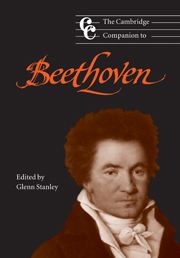Book contents
- Frontmatter
- Part I A professional portrait
- Part II Style and structure
- Part III Genres
- 7 The piano music: concertos, sonatas, variations, small forms
- 8 Beethoven's chamber music with piano: seeking unity in mixed sonorities
- 9 Manner, tone, and tendency in Beethoven's chamber music for strings
- 10 Sound and structure in Beethoven's orchestral music
- 11 Beethoven's songs and vocal style
- 12 Beethoven's essay in opera: historical, text-critical, and interpretative issues in Fidelio
- 13 Probing the sacred genres: Beethoven's religious songs, oratorio, and masses
- Part IV Reception
- Notes
- Selected further reading
- General index
- Index of Beethoven’s compositions and sketches
- Plate section
8 - Beethoven's chamber music with piano: seeking unity in mixed sonorities
from Part III - Genres
Published online by Cambridge University Press: 28 September 2011
- Frontmatter
- Part I A professional portrait
- Part II Style and structure
- Part III Genres
- 7 The piano music: concertos, sonatas, variations, small forms
- 8 Beethoven's chamber music with piano: seeking unity in mixed sonorities
- 9 Manner, tone, and tendency in Beethoven's chamber music for strings
- 10 Sound and structure in Beethoven's orchestral music
- 11 Beethoven's songs and vocal style
- 12 Beethoven's essay in opera: historical, text-critical, and interpretative issues in Fidelio
- 13 Probing the sacred genres: Beethoven's religious songs, oratorio, and masses
- Part IV Reception
- Notes
- Selected further reading
- General index
- Index of Beethoven’s compositions and sketches
- Plate section
Summary
The essential problem in writing music for strings or winds with piano is immediately apparent: the sonorities do not readily mix. Stringed and wind instruments naturally produce sustained sounds, whereas a piano note decays from the moment it is struck – and decayed even more rapidly on eighteenth-century pianos than on today's. Hence, the expressive possibilities of the instruments are different and often contradictory; and as increases in virtuosity made their capabilities more specific, these differences become more pronounced. Despite this problem, chamber music with piano had a well-established and important role in eighteenth-century musical life, and the greatest composers were able to find ways for contrasting instruments to occupy the same musical space happily. Beethoven's role in this process was unique, because his years of creative genius coincided with a period of rapid development, both in instrumental design and instrumental technique. He was therefore a pivotal figure in the development of chamber music with piano – especially the still-young genres which will be the focus of this essay: duo sonatas with violin or cello, and trios with both instruments.
Much of this music was composed early in his career, from the mid 1790s until 1803, after which the seven remaining masterpieces (1808–15) integrated his earlier technical breakthroughs with later stylistic advances. Beethoven's choice of piano trios for his debut opus was a natural one: as a student he had experimented with both piano trios and piano quartets, and his teacher Haydn was the composer of several remarkable piano trios. The three op. 1 trios are not at all modeled on Haydn’s trios in the way that they combine string and piano sonorities; Beethoven was already seeking his own answers to such textural problems.
- Type
- Chapter
- Information
- The Cambridge Companion to Beethoven , pp. 127 - 146Publisher: Cambridge University PressPrint publication year: 2000



